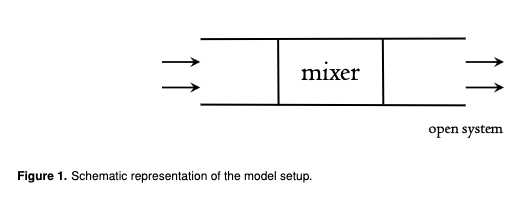Scientific read of the day #VisMaVieDeScientifique #Science #Mixer
Recent searches
Search options
#mixer
No-Input Mixer 0.1
first recording of a long series of improvisations on no-input mixer based on the fx numbers of the #behringer xenyx 1222fx.
#electronicmusic #noise #noinputmixer #youtube #live #performance #soundart #music #recording #mixer #noinput #improvisation #sound
https://youtube.com/watch?v=8NorYm5GXtM&si=rwbdDO4vfSFcameb
This is the other end of the XLR cable pulled, out of the instrument mixer, where it's normally plugged into Channel two.
Of course since a bass guitar is a mono single channel instrument, I only use one channel if I had used a dual Channel effect somewhere in the effect chain, usually at the end, I would have two of these patch cables getting out of that effect, and getting into both ports of Channel two of the instrument mixer
The one end of the XLR cable, is plugged into one of my Bass effects, an overdrive
Here's the photograph with connector one at the end of the reduced XLR cable
Today I decided to create another patch cable, within my long line of patch cables, important for sending signals from effects, whether they be discrete analog effects, or effects which process the signal digitally, then spit them back out in an analog wave.
It was important to make this cable because I was using an expensive higher grade cable which I need somewhere else. The cable that I used is a standard XLR cable which has ground signal 1 and signal 2. You can go read on Wikipedia why XLR needs that in detail, but it has to do with the length of an XLR cable which can go to 30 m if you need it.
The signal that I need to carry only needs an unstable connection which means a signal and a ground. My XLR cable is een overkill but I don't have any other cable.
Enthusiastically I warmed up my trusted Weller soldering iron, waited till it heated up, took my fantastic cable stripper stripped the cable on both ends, prepared the connectors beforehand and started soldering.
Everything went smoothly I've been soldering since I'm a 7 year old kid. Of course quality control is important so my multimeter was tuned on diode.
For the uninformed, a diode is a electrical component which only lets current on one side, and then blocks it from the other side. This setting is also used to check the connections & continuity in cables and on ports.
When I was done something strange occurred. I measured the cable and the mass, the common was open. Checking both sides of the soldering work showed it was perfect. Not believing that there could be disruption in the cable, I stripped one side then measured the cable and came to the same conclusion broken Mass. I caught and stripped another small section of the cable at the other side and still an open Mass.
So I've had a piece of XLR cable, that didn't ground and I had used that as a stable cable, which had given me all kinds of interesting artifacts, that I alleviated by just stripping out that one piece of cable, years ago.
Now a regular person would take that cable and chunk it on the side. I on the other hand I'm not a regular person, I started stripping / dismantling radios when I was two and when I was five I had such a skill that it looked like a trained electronic professional had stripped the radio. Are we talking about radios in the Tube era, where hundreds & hundreds of Volts and many Ampères were going through those circuits.
XLR cable has three conductors; signal one, signal two and ground. I used the white conductor as the new Mass, the new ground and used the red conductor as a signal two, thus making a balanced XLR cable unbalanced because the ground conductor was broken.
It was a wonderful trip, taking this piece of XLR cable and reusing it again even though only two conductors were usable effectively.
I may provide photographs later.
I'm thinking about a small #mixer as a #soldering set again. Here is a simple mono design, that I once came up with.
Now I would like to do it in the style of the new noisio #synth #kits, with USB-C and the housing.
What about adding another line of knobs to add one more key feature, like making it stereo (panning), have an Aux channel or build a 1 knob super filter over the whole frequency range (this is what I am dreaming about :).
What would you go for?
Fundamentals of FMCW Radar Help You Understand Your Car’s Point of View - Pretty much every modern car has some driver assistance feature, such as lane depa... - https://hackaday.com/2024/10/19/fundamentals-of-fmcw-helps-you-understand-your-cars-point-of-view/ #transportationhacks #beatfrequency #radiohacks #automotive #sensor #mixer #radar #fmcw #fft #pll
Matchbox Transceiver Pushes the Spy Radio Concept to Its Limits - The Altoids tin has long been the enclosure of choice for those seeking to show of... - https://hackaday.com/2024/05/09/matchbox-transceiver-pushes-the-spy-radio-concept-to-its-limits/ #amateurradio #transceiver #radiohacks #80-meter #matchbox #sidetone #deadbug #dipole #ne5532 #mixer #morse #ham #cw
Kenwood Chef calamity! This is tragic. My grandmother's 1960s era mixer. I have a heap of the attachments too including mince and blender.
This doesn't look fixable really. Now to decide: replace with a modern one or find a second hand unit?
You Can Use A Crappy Mixer As A Neat Synthesizer - [Simon the Magpie] found himself in possession of a Behringer mixer that turned up... - https://hackaday.com/2024/01/25/you-can-use-a-crappy-mixer-as-a-neat-synthesizer/ #musicalhacks #mixer #music #synth
Another discovery I've made (and am still trying to figure out) is the monitoring in Logic. I can monitor just fine and hear my virtual amp plugin just fine when I'm noodling. If I hit play so I can practice against the track, all I get is the raw guitar, no plugin. But if I hit record, I can play & hear the plugin. Very odd, I'm just not getting why (yet).
Spy Transceiver Makes Two Tubes Do the Work of Five - Here at Hackaday, we love following along with projects as they progress. That’s e... - https://hackaday.com/2023/05/19/spy-transceiver-makes-two-tubes-do-the-work-of-five/ #continuouswave #transceiver #radiohacks #oscillator #vacuumtube #sidetone #spyradio #amateur #mixer #relay #ham #cw
Another new song! #Hot off the #mixer! #music #newmusic #musicproduction #spirit #inspirational
More music for #mastodon
Lyrics by @atomic
Music, performance, mix by me.
Hope U Like!
https://thekidshouldseethis.com/post/playing-with-the-teenage-engineering-tx-6-mixer
Listen as Shawn of #Lullatone records his mic and onboard effect experiments with a new pocket-size #mixer
trying to decide between a KitchenAid Professional 500 and a KitchenAid Pro Line Series 7
◆ #SoundEngineering
Professional #Yamaha 16x4x2 #mixer in recursive composition
◆ https://twitch.tv/radioazureus @Nowansma






